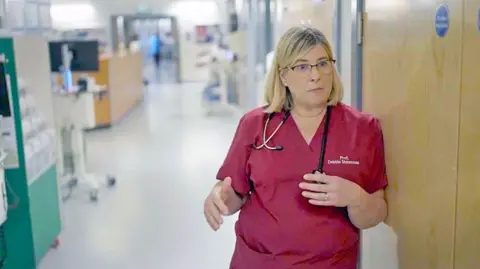 Daniel Taylor-Sweet / BBC
Daniel Taylor-Sweet / BBCAt 31 years old, I was told by doctors that if I didn’t stop drinking alcohol, I could die.
I was shocked because I didn’t drink every day, I never drank alone and I drank because I enjoyed it as a social activity, not because I felt alcohol-dependent.
But by definition, my alcohol consumption from my late teens to late 20s would be considered binge drinking. It felt normal because people around me were doing the same – and now it was catching up with me.
I’d recently become a mum and had gone to the GP because I felt tired all the time. This led to blood tests and a liver function check.
Further tests revealed I had severe alcohol-related liver fibrosis, or extreme scarring on my liver, most likely because of my drinking habits.
I trundled home from the hospital in a daze, with my daughter in her pram. This might have happened to me, I thought, but I could not be the only one.
I wanted to know what this said about the UK’s drinking culture and began looking into it for BBC Panorama.
Alcohol-specific deaths are at their highest levels in the UK since records began in 2001.
While the problem is undoubtedly bigger in men – particularly older men – more women under the age of 45 are dying due to alcohol-related liver disease, or ARLD, than ever before, according to Office for National Statistics (ONS) figures from 2001-22.

If we binge a given amount of alcohol in one go – for example on a night out – it can be much more damaging than if we drink the same amount over a longer period.
The latest research, by a team at University College London and the universities of Oxford and Cambridge, suggests bingeing may be up to four times as damaging for the liver.
When we think of binge drinking, we tend to imagine people drunkenly sprawling out of bars and falling over at bus stops. But actually, a binge can be less alcohol than you might think.
In the UK, a binge is considered as drinking six or more units of alcohol in one sitting for women, and eight or more for men. That is two large glasses of wine for a woman.
At King’s College Hospital in London, consultant hepatologist Debbie Shawcross tells me that she regularly treats professional women in their 40s and 50s with liver disease.
“They’re spinning plates in the air, and maybe they have young families,” she says. “They’re not alcoholics… but they are just drinking too much as a habit.”
I’m not in my 40s yet, but she could have been describing me.
When I was younger, I would easily drink more than what’s defined as a binge on a night out. I didn’t think anything of it until I got my diagnosis.
After my blood tests came back as abnormal I was sent to Glasgow’s New Victoria Hospital, where I had an ultrasound, and finally a fibroscan. All this took place over the course of about a year.
A fibroscan is a type of non-invasive ultrasound which measures liver stiffness. A reading of seven kPA (a unit used to measure the level of oxygen in the blood) or below is considered normal. My reading was 10.2.
This indicated severe scarring – if it had not been caught, and if I had not stopped drinking, it could have developed into cirrhosis.
I received my diagnosis in February 2024. My consultant, Dr Shouren Datta, said if I abstained from alcohol, then there was a possibility that my fibrosis could be reversed.
 Rachel Adam
Rachel AdamI feel extremely lucky that the problem was picked up in time for me to try to do something about it.
Doctors had discovered the problem while investigating my tiredness.
However, part of the problem with liver disease is that there are often no initial symptoms.
Seven in 10 people with end-stage liver disease don’t know anything about it until they are admitted to hospital with symptoms such as jaundice, fluid retention and abnormal bleeding.
That is what happened to Emma Jones, 39, originally from north Wales. I met her 15 months after her successful liver transplant.
Like me, Emma was a social drinker, with a successful career and vibrant social life. But during the Covid lockdowns things spiralled for her – at the worst point, she was drinking three bottles of wine a day.

Emma was admitted to hospital where she found out she was in end-stage liver disease. She was given less than 36 hours to live.
Miraculously, she pulled through and – after fulfilling the required six months of sobriety – got the transplant she so desperately needed.
Emma’s recovery is ongoing and is not without major life changes. She will be on anti-rejection drugs for the rest of her life and is immunosuppressed, meaning it is harder for her body to fight infections and disease.
But she is alive, well, and says she is in the best place she has ever been. I find her positivity and determination infectious.
‘Gin o’clock’
According to the most recent ONS statistics, from 2018, liver disease is consistently among the top three causes of death each year among women aged 39-45.
“Women’s drinking pretty much doubled in a really short period of time… about 10 years,” Prof Fiona Measham, a leading expert in drink and drug culture from the University of Liverpool, tells me.
Her research suggests that in the 1990s and 2000s, the alcohol industry zeroed in on female drinkers, targeting them with products such as alcopops and shots – and using feminism, female empowerment and liberation as a marketing tool.
She thinks these practices established a drinking culture in a whole generation of young women that would leave a lasting legacy.
“What we’re seeing now is that young people, their consumption is falling fastest, but it’s still holding quite steady for people in their 30s, 40s and 50s,” she says.
The same aggressive approach persists today within the alcohol industry, believes Prof Carol Emslie, from Glasgow Caledonian University. Only now it is pushing things like prosecco, “gin o’clock” and “wine time” as a way for women to relax and practise self-care after a hard day.
The Portman Group, which represents the alcohol industry, says:
While “the increase in alcohol-related liver disease among both women and men in the UK is a serious concern, it’s important to remember that alcohol has always been a legal product.”
It says its Code of Practice… “does not protect against gender-based marketing specifically” but sets “minimum standards for alcohol producers to market their products responsibly”.
And it is “committed to continuing…(its) efforts to promote moderate drinking as well as holding the alcohol industry to account.”
- Support and information for anyone affected by these issues can be found at BBC Action Line

BBC journalist Hazel Martin goes on a personal journey to find out why alcohol-related deaths from liver disease among women under 40 have risen sharply over the last decade.
Watch now on BBC iPlayer or on Monday 25 November at 20:00 (20:30 in Wales and Northern Ireland) on BBC One.

Several months after my diagnosis, I went back for a repeat fibroscan to see if there had been any improvement.
I was relieved to see that my fibroscan reading had gone from 10.2 to 4.7 – back in the normal and healthy range.
I was surprised what a dramatic difference cutting out alcohol had made in such a short space of time.
I don’t plan on drinking again – I’ve been advised not to.
I haven’t touched a drop for nearly a year and feel much better for it – but I still mourn it in a way I can’t quite put my finger on.
Alcohol is ingrained in our culture. We drink at birthday parties, weddings and funerals. And then of course there’s the festive season, which builds up ahead of Christmas and lasts right through to New Year’s Day.
For me growing up, alcohol felt normalised and I don’t think I was fully aware how much pressure there was to drink until I was forced to give it up.
Abstaining hasn’t been easy though. It has taken a long time to reprogramme my brain to not need or want alcohol as a treat, a reward, or as a way to relax and have fun socially.
I think that was part of the problem for me then, and it remains a problem for our society now.
Additional reporting by Amber Latif and Kirstie Brewer


